Wondering when is the best time to visit Switzerland? If you’re already planning your visit to the Swiss Alps, then you know that choosing the best time of year isn’t as obvious as you might think.
You wanna maximize your experiences, enjoy perfect weather with minimal crowds, and to top it off, you’d love to do it on a budget. But does this idyllic time of year even exist?
>>Just here for the free download? Here it is!
Prefer to WATCH instead of READ? Here ya go!
Hey, we’re Jana and Brett, and this beautiful slice of Switzerland has become our adopted home for the past 2 summers (since 2021). But we don’t just spend time here for our enjoyment — we’re on a mission to help you maximize your trip to Switzerland while minimizing your budget and planning time.
So today we’re gonna help you decide when is the best time to visit Switzerland, based on questions you often ask us about in the comments of our YouTube videos:
- What’s the weather like?
- Which months are cheaper or more expensive?
- What’s open and which trains/mountain lifts are running?
We’ll answer these questions month-by-month using real data. But you know we’re gonna give you more than just the facts, right? So after working our way through the calendar, we’re gonna get down to the nitty gritty—sharing when we would choose to visit based on sightseeing priorities and travel preferences that are way more personal than any amount of research.
So are you ready to plan your trip to Switzerland? Let’s go.
Follow along using our free spreadsheet download of month-by-month weather data, average Airbnb costs, and train openings!
Weather in Switzerland Year Round (Month-By-Month)
As we work through the calendar, here’s what we’ll highlight for each month using data for Interlaken, Switzerland since that’s the hub of the region (and may be one of the best places to visit in Switzerland):
- Average high temperature
- Average # of days with sunshine
- Average # of days with precipitation (rain or snow)
- Average cost of an Airbnb during the month
- Which railways and cable cars are open or closed
Keep in mind, though, that averages only tell some of the story. This region frequently has extreme weather swings, so your experience could be quite different than the averages indicate. And of course, it can change quite drastically depending on the altitude.
So use this as a guide to help make your decision, and then commit to having a great time on your trip to the region no matter what the weather throws at you!
Switzerland Weather in January
- Temperature: 36°F
- Sunshine: 7 days
- Precipitation: 9 days
- Lodging: 4th least expensive
It’s no surprise that the first month of the year is also the coldest, with an average high temperature of 36 °F, 7 days with sunshine, and 9 days with precipitation.
It’s also the 4th least expensive month based on airbnb data.
During January, you’ll find that most of the important mountain trains and cable cars are running, with the exception of ones that run only in summer such as the funicular to Harder Kulm, the cogwheel train to Schynige Platte, and the steam train to the Brienzer Rothorn.
The Berner Oberland Regional Pass (our favorite!) won’t be available for a few more months, but in the past few years a winter version of the Top of Europe pass has been available.
If you love snow or snowsports, then January is obviously a great month to visit, and there are even sledding, snowshoeing, and winter hiking tracks too.
Switzerland Weather in February
- Temperature: 40°F
- Sunshine: 5 days
- Precipitation: 3 days
- Lodging: least expensive month
February looks a lot like January in many ways. The average high temperature is slightly warmer at 40°.
You’re likely to see snow or rain just as often as in January. But it has one of the lowest amounts of total precipitation for the entire year.
But It’s typically not as sunny, with an average of just 5 days with sunshine—however, February also has fewer days, so there is that 😉
A benefit of traveling in February is that it’s the least expensive month to book a rental on Airbnb. And as for rail operation and travel passes, you’ll pretty much find the exact same availability as January.
When is the best time to ski in Switzerland? Possibly February because that’s when the locals go. Schools typically close for a week or two in February and lots of Swiss use this time to go skiing. So if you’re coming primarily for a ski trip you might want to avoid this month, or at least be aware of how school holidays might impact the crowds and prices.
Switzerland Weather in March

- Temperature: 48°F
- Sunshine: 10 days
- Precipitation: 11 days
- Lodging: 5th least expensive
March is kind of a weird month in a lot of ways. Winter is starting to say goodbye, especially at lower elevations, but it really isn’t spring yet either.
There’s an average high temp of 48° in Interlaken with 10 days with sunshine and 11 days with precipitation. But your experience could really vary depending on where you visit.
Lower elevation ski areas such as Oeschinensee and the Niederhorn wrap up their winter season and close for maintenance by the middle of the month.
And airbnb prices are beginning to pick up, but it’s still the 5th least expensive month of the year.
Switzerland Weather in April
- Temperature: 54°F
- Sunshine: 14 days
- Precipitation: 12 days
- Lodging: 7th least expensive
April really is the beginning of Spring in Switzerland, especially at lower elevations. Interlaken sees an average high temp of 54°, but you’ll probably see days in the 60s as well, especially later in the month.
There are an average of 14 days with sunshine and 12 days with precipitation, but it also ranks 7th for your budget, indicating that international tourism is beginning to come out of hibernation.
The Top of Europe summer pass is usually available around the middle of the month, but it’s a complicated time to plan your sightseeing. More cable cars and mountain trains are shut down part of the month for maintenance, with the Schilthorn included in that mix.
But the funicular to Harder Kulm opens midway through the month, and might just be the best spot for a sunset view on a clear day.
And around this time, you also see Lake Thun and Lake Brienz spring back to life, with boat cruises beginning to run regularly. It’s not a great time for hiking or skiing in the high mountains, but at lower elevations it might be one of the most beautiful times of year.
Waterfalls and rivers flow freely, wildflowers begin to bloom, and it’s all set against the backdrop of snow-capped mountains.
Keep in mind that schools also closed for a week or two around Easter for a spring break of sorts. So you might find more Europeans traveling and perhaps some smaller shops or restaurants closed for the break.
Need a cheat sheet?
I know, this is a lot of technical information. But when you’re planning a trip to the mountains, this is the stuff you need to know!
So we created a free download with all of the weather data and Airbnb stats we’ve been referencing, plus we made a comprehensive chart of 23 trains, cable cars, and funiculars in the Jungfrau Region and which months they’re open or closed.
Sign up for the free download and it will be sent straight to your inbox!
But for now, let’s dive into the next few months which are the peak tourism season in the Swiss Alps.
Switzerland Weather in May
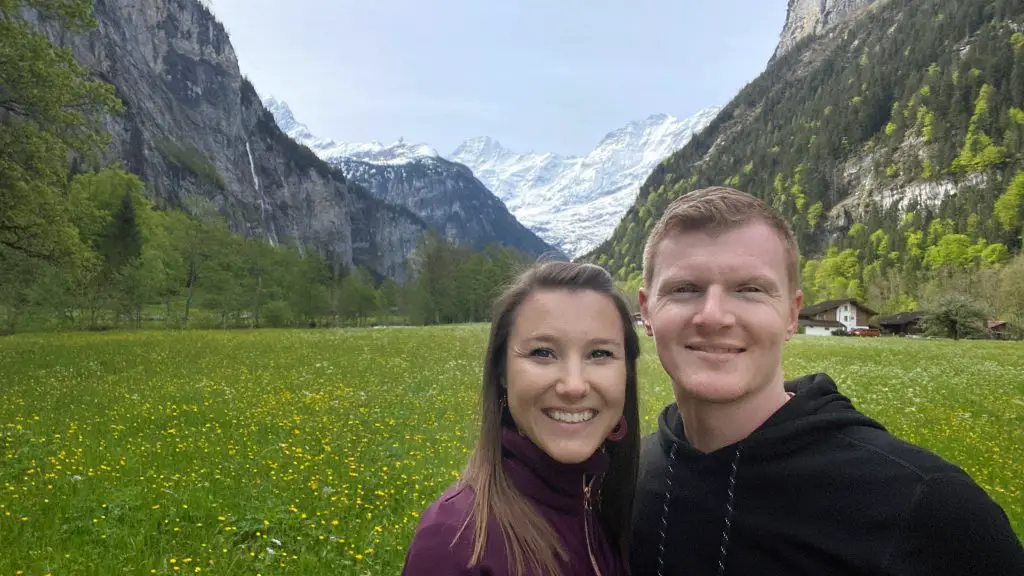
- Temperature: 64°F
- Sunshine: 11 days
- Precipitation: 19 days
- Lodging: 9th least expensive
May feels more like the springtime you might be used to with average high temperatures of 64° and plenty of days well into the 70s.
It also rains like the spring you might be used to—with just 11 days with sunshine and 19 days with precipitation on average, making it the rainiest month of the year. (Maybe that’s why they call it “spring?”)
But as colleges in the U.S. wrap up their spring semesters, you’ll see the return of more international tourists, as well as higher prices on airbnb.
There are still times of maintenance for some of the mountain railways and cable cars; but very few of them are shut down for the entire month.
The cable car and train from Lauterbrunnen to Mürren is closed for maintenance for a couple weeks. But thankfully the Schilthornbahn is open once again so you can reach Mürren using that cable car instead.
On top of that, the cogwheel train to Schynige Platte and the gondola to the beautiful blue lake at Oeschinensee are running by the end of the month, and you’ll finally be able to use our favorite train pass: the Berner Oberland regional pass.
Oh and we forgot to mention that our free download also shows you which train passes are available for every month of the year.
Switzerland Weather in June
- Temperature: 70°F
- Sunshine: 12 days
- Precipitation: 18 days
- Lodging: 2nd most expensive
When June comes around it’s officially summer in Switzerland—both in terms of weather and tourism.
The average high temperature is just 70°, but you’ll likely see temps reach well up into the 80s at some point.
June sees an average of 12 days with sunshine. But along with the heat, you’ll also see plenty of precipitation.
The first part of the month can still feel like Spring in Switzerland, depending on the year. But by the middle of the month we’re very much into high season, making this the 2nd most expensive month according to airbnb data.
A couple of mountain trains and funiculars, like the one to Allmendhubel, wait until the first or second weekend of the month to open for the summer season, but by the middle of the month, everywhere you’d like to visit in the mountains is open.
Schools break for the summer starting early in the month, which means you’ll definitely notice a difference in how busy this place gets as June moves along.
And that definitely won’t show any signs of slowing down as we move into July.
Switzerland Weather in July
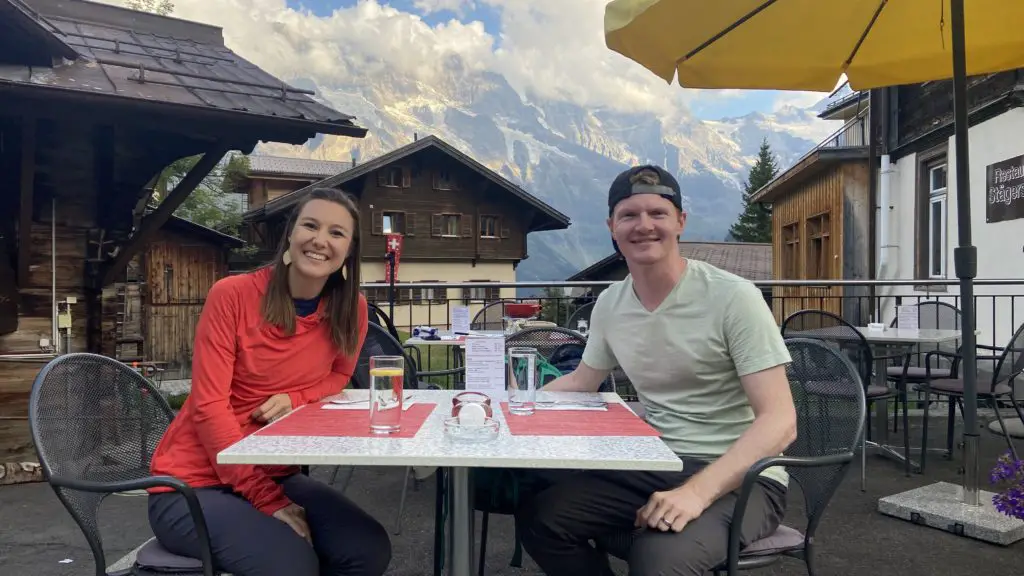
- Temperature: 75°F
- Sunshine: 14 days
- Precipitation: 17 days
- Lodging: Most expensive
July could probably be thought of as the high of high season, and there are plenty of good reasons for that:
- Schools and universities are on break in Europe and North America, bringing tons of international travelers.
- The snow has melted at most higher elevations, making world-class hiking trails available all over the region.
- The weather is the warmest and the days are the longest.
While the average high temperature is only 75°, don’t be surprised to see that thermometer stretch up into the high 80s or even the 90s.
Your chances of sunshine tend to be higher than during the Spring, but you’re probably going to see your fair share of rain as well.
Unfortunately all that means July is also the most expensive time to book an airbnb. But along with high prices and lots of daylight, you also have every summer activity imaginable at your disposal.
All of the mountain trains and cable cars are running throughout the entire month, and this is also the perfect time for cruising on—or even swimming in—the lakes.
If you’re coming for summer sports activities and are willing to pay a premium and endure the crowds, July is a safe choice.
Want more helpful Swiss travel tips delivered to your inbox each week? Make sure to get on our email list so you don’t miss out!
Switzerland Weather in August
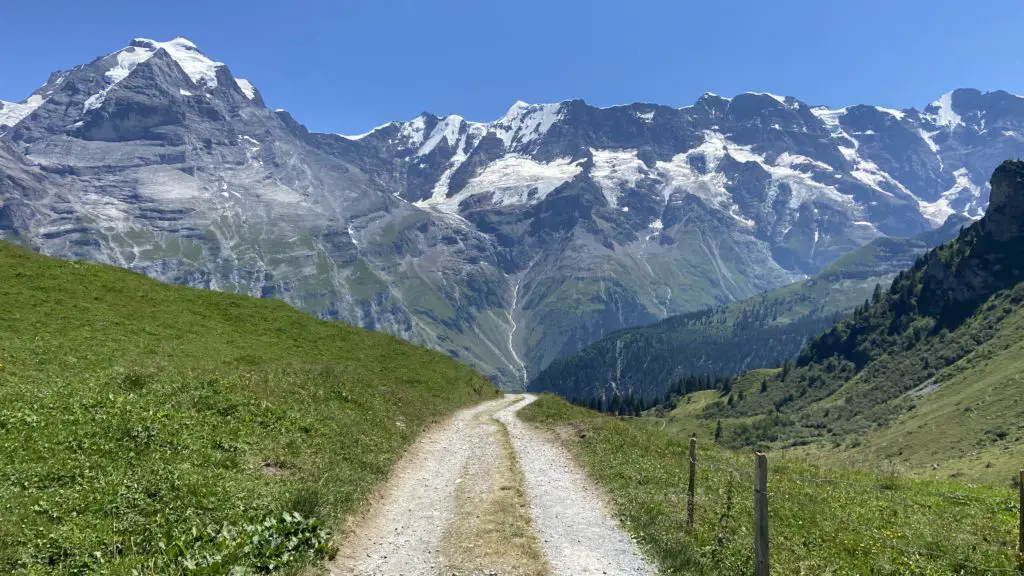
- Temperature: 75°F
- Sunshine: 16 days
- Precipitation: 15 days
- Lodging: 3rd most expensive
Moving on to August, it would be a mistake not to mention that the 1st of the month is the Swiss National Day, kind of like Independence Day in the U.S.
There are activities and parades in nearly every village and town, and we think it’s a lot of fun to be in Switzerland during this time. But you’ll likely see a lot more of the Swiss traveling to the area and some small shops might be closed at least for the day, so keep that in mind.
August has the same average high temperature as July, and the first part of the month is almost certainly going to feel like the heat of summer. But as the month goes along, you just might find hints of Fall temperatures around the corner.
It also tends to be a little more stable than Spring and early Summer, with an average of 16 days with sun compared to 15 days with precipitation.
August is the 3rd most expensive month on airbnb. But just like July, all of the mountain trains and lifts will be running, making it another fantastic month for summer sports of all kinds.
Switzerland Weather in September
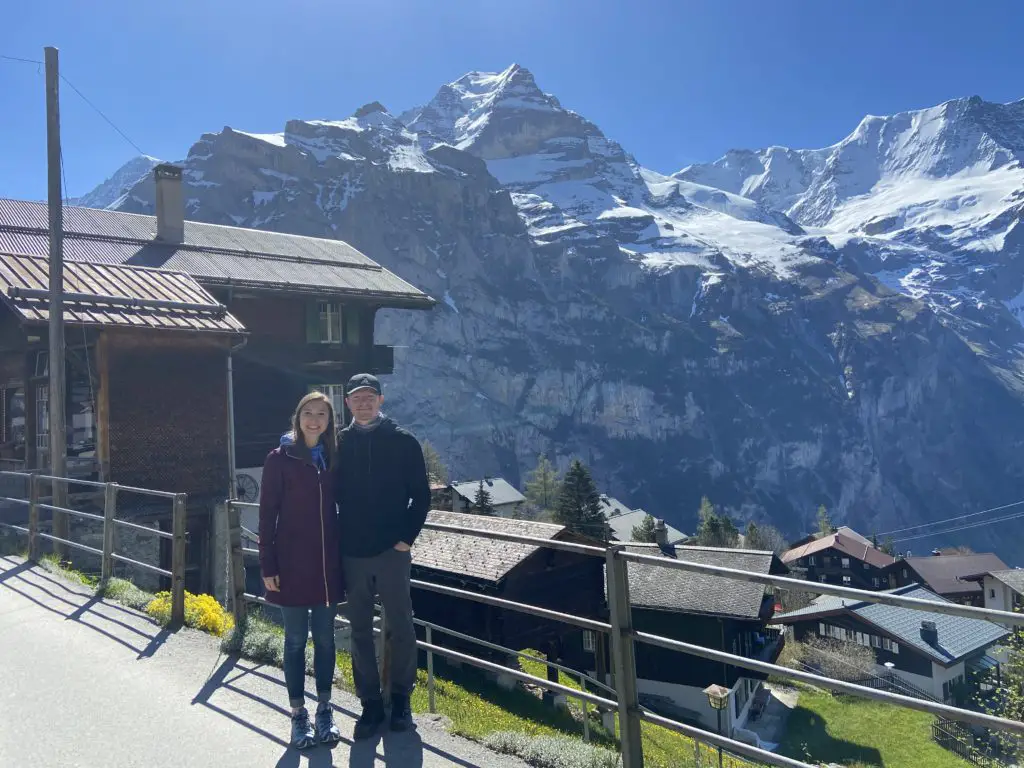
- Temperature: 68°F
- Sunshine: 20 days
- Precipitation: 10 days
- Lodging: 5th most expensive
By early September, schools are back in session in Switzerland, Europe, and North America, so you’ll notice a discernible decrease in the number of tourists.
The average high temperature drops back to 68°, but there is normally still an abundance of sunshine and quite a bit less rain, and you’ll probably see plenty of days with temperatures in the 70s.
It’s the 5th most expensive month on airbnb, but all of the mountain trains and cable cars are still running, making it a solid option for those traveling on a budget who still want high mountain hiking options.
The last two years we’ve noticed pretty drastic weather changes between the first and second half of the month. And while that might not be typical every year, it’s worth mentioning that Autumn really has arrived by the end of the month.
All that to say, if you crave warm temperatures and long, sunny days, both are likely gone by the time the calendar changes to October! But to us, the blue September skies just look a little clearer and this is one of our favorite months to visit this region.
Switzerland Weather in October
- Temperature: 57°F
- Sunshine: 22 days
- Precipitation: 8 days
- Lodging: 6th least expensive
Speaking of October, this is the month when the locals enjoy spending time in their mountains.
Schools are on break for a couple weeks and most international tourists have packed up and left, so October is perhaps one of the most authentic times to enjoy the Jungfrau Region.
The weather tends to be pretty cooperative too, even though it’s quite a bit cooler, with an average high of 57° and temperatures rarely reaching beyond the 60s.
If you like sunshine and cooler temperatures, this just might be the month for you. 22 days with sunshine compared to just 8 with precipitation makes this one of the sunniest and driest months of the entire year.
Having said that, October will also bring a few more planning complications compared to the summer in Switzerland. By the end of the month, lots of mountain trains and lifts start closing for maintenance, with Grindelwald First included in this group.
But all in all, October (which is the 6th least expensive month) might just be an all-around bargain. With Fall colors on full display, and fresh mushrooms and local game on offer at restaurants, there’s a lot to love about this time of year.
If you’re thinking the Jungfrau Region is where you want to visit, check out our 1 Week Guide to the Jungfrau Region for a complete 7 day travel itinerary!
Switzerland Weather in November
- Temperature: 45°F
- Sunshine: 15 days
- Precipitation: 8 days
- Lodging: 3rd least expensive
What can we say about November? For starters, it seems to have a bit of an identity crisis. It’ll make you think it’s Autumn in Switzerland and it’ll also tell you it’s Winter—and sometimes both at the same time!
The average high temperature is 45°, but you might see days with highs in the low 30s and other days in the low 60s.
The amount of sunshine also drops quite a bit, though you likely won’t see huge amounts of precipitation either. Gray, misty fog just might be the best picture of an average day in November.
But November is also the 3rd cheapest month according to airbnb.
Most of the summer trains and cable cars have shut down by this point, and even the Schilthorn goes into maintenance mode partway through the month.
Jungfraujoch is open 365 days a year, but even a visit there could be more complicated. Both the Eiger Express from Grindelwald and the train from Wengen to Kleine Scheidegg are closed for maintenance for part of the month, meaning it could take up to an hour longer than normal to reach Jungfraujoch depending on where you’re staying.
Answers to your travel questions
Travelers just like you have asked us a ton of questions about when to visit, what’s the weather like, and what to do if the lifts are closed—and this post and our free download are made to give you a realistic picture of what it’s like to visit Interlaken during each month of the year.
Just want to remind you to snatch up the free-and-helpful goodness using the form below!
And now, let’s wrap up with the final month of the year.
Switzerland Weather in December
- Temperature: 38°F
- Sunshine: 11 days
- Precipitation: 8 days
- Lodging: 2nd least expensive
If Christmas markets, mulled wine, puffy coats, and snow sound charming to you, then you’re probably going to love December.
I’m sure we don’t need to tell you it’ll be cold, with average high temperatures in the upper 30s. But that’s what gets you in the holiday spirit, right?
Unsurprisingly, the amount of sunshine drops along with the temperatures, but average precipitation for the month remains pretty low.
If you avoid the days surrounding Christmas and New Years, December is pretty budget friendly, with airbnb ranking it the 2nd cheapest month of the year.
Though the first half of the month still has quite a few closures, all the important ski areas and sightseeing spots—including Grindelwald First and the Schilthorn—will be open and waiting for your visit.
So if you like the holiday season and know how to pack your layers, December in the Jungfrau Region could be an experience unlike anything you’ve enjoyed before!
That was helpful but…now what?
We’re all about helping you maximize your trip while minimizing your budget and planning time, so here are some bonus tips that will help you decide when to visit based on specific priorities and activities.
Waterfalls
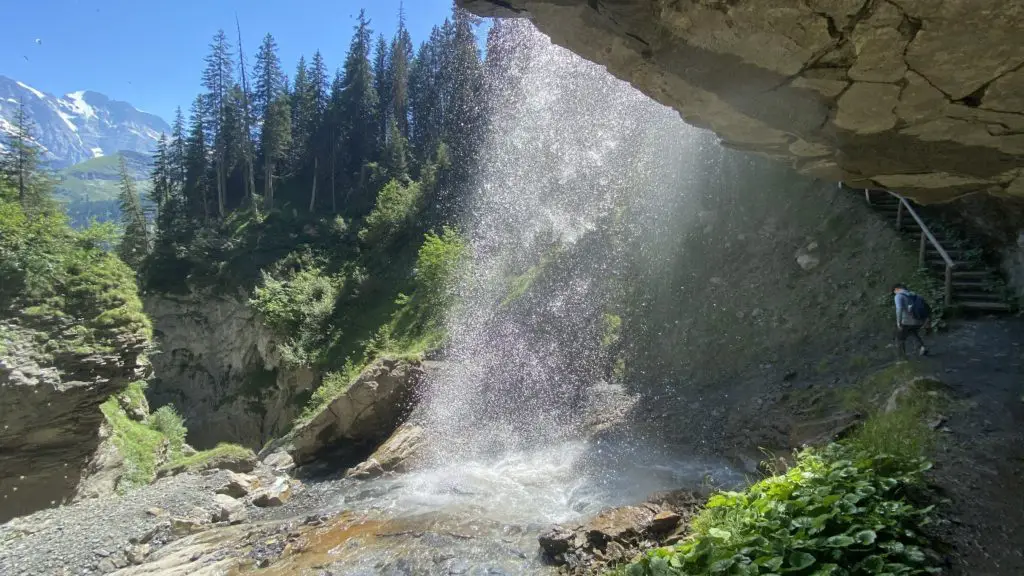
We get lots of questions like, “When is the most beautiful time to visit the Swiss Alps?”
While that’s an impossible question and every time of year is beautiful here, we know this usually means a few things: wildflowers in bloom, green alpine meadows, and waterfalls filled to the brim with snow melt.
To enjoy scenes like these that inspired even great writers like Tolkien, there’s nothing like Springtime in the Jungfrau Region. Particularly, aim for mid-April to mid-June.
Giessbach Falls will be raging, the Sprutz and Staubach falls will be plunging mightily, and the entire Lauterbrunnen Valley will look like a fantasy.
If you’re looking for the best combination of springtime beauty and hiking availability, look to June. You might not be able to access the highest of alpine hikes, particularly early in the month, but you’ll find plenty to keep all of your senses busy!
Hiking
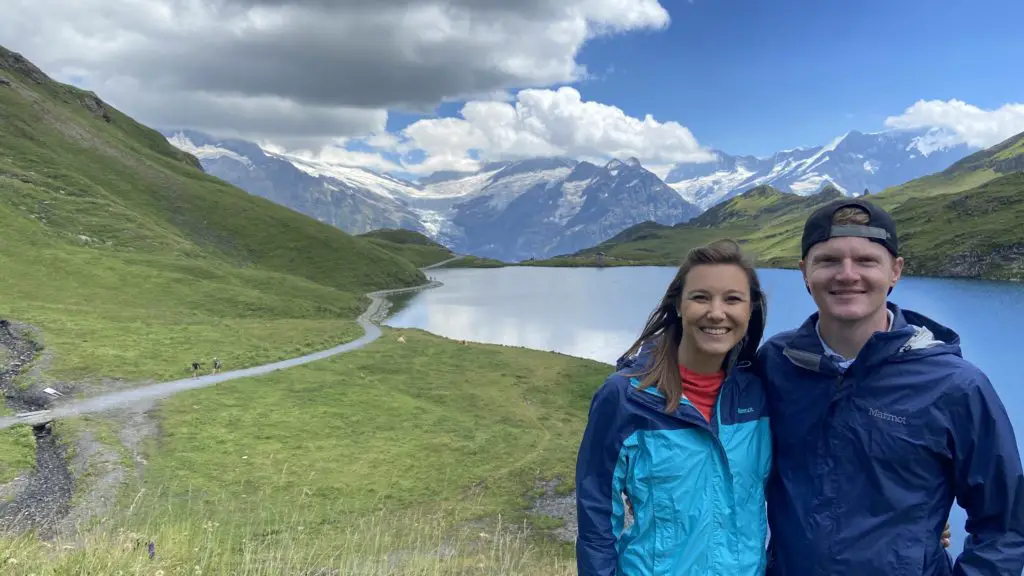
If you’re like us and you love hiking in the Swiss Alps, then plan your visit sometime from June to September. A word of caution though about June: snow sometimes covers trails above 2000m well into the month. So if it’s really important to you to have the best trails available with good conditions, you might wanna wait until at least the second half of June.
And if you’re looking for fewer tourists and perhaps a lower budget, the first half of September has proved to be a great time to visit. You’re less likely to experience extreme heat, the weather is a little more stable, and the snow usually hasn’t yet returned even at higher elevations.
Now if the hiking you’re more interested in isn’t so high in the mountains, mid-May to mid-June and mid-September to mid-October could be a great choice as well. But don’t count on being able to hike mountain trails above 1700 or 1800, even though it might be possible depending on the year.
Lakes

It goes without saying that if you like to swim in the lakes and you’re not cold-blooded, July and August will be the best times to visit.
But enjoying a nice boat ride on Lake Thun or Lake Brienz can happen anytime from mid-April until the last week or so of October. This entire time is also great for lakeside strolls.
Winter in Switzerland
If you love winter wonderlands yet winter sports aren’t your reason for traveling, it’s hard to imagine a better time to visit than December, when the Christmas markets and decorations are in full swing, and the charm level is dialed up to a 10 out of 10.
If winter sports are your jam, we’ve heard that January and February are the best time to ski in Switzerland, although February is particularly busy due to school breaks. So December and March might offer fewer crowds and better prices.
But admittedly, we aren’t skiers, and we haven’t yet been here for Winter in Switzerland. But we wanted to share our perspective with you based on our own experience as well as lots of research.
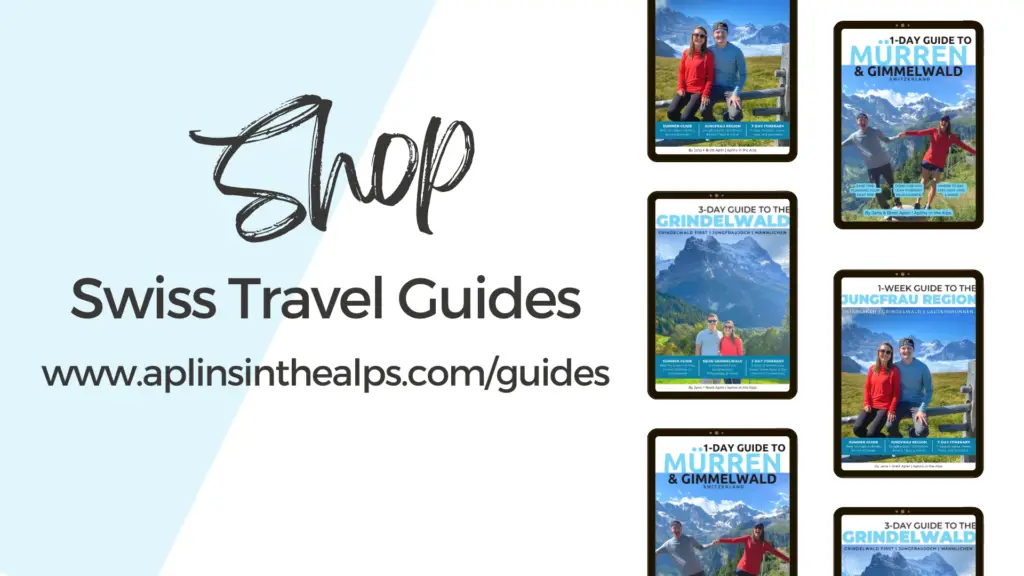
Now that you know when you want to visit Switzerland, shop our travel guides for complete itineraries to some of the top places to visit while in Switzerland!
And don’t forget to get our FREE When is the best time to visit Switzerland download!
Our goal is to help you travel with confidence by reducing your planning time and stretching your budget, and that’s exactly what our free download does!
So check your inbox for the free guide, and we’ll see you in Switzerland!

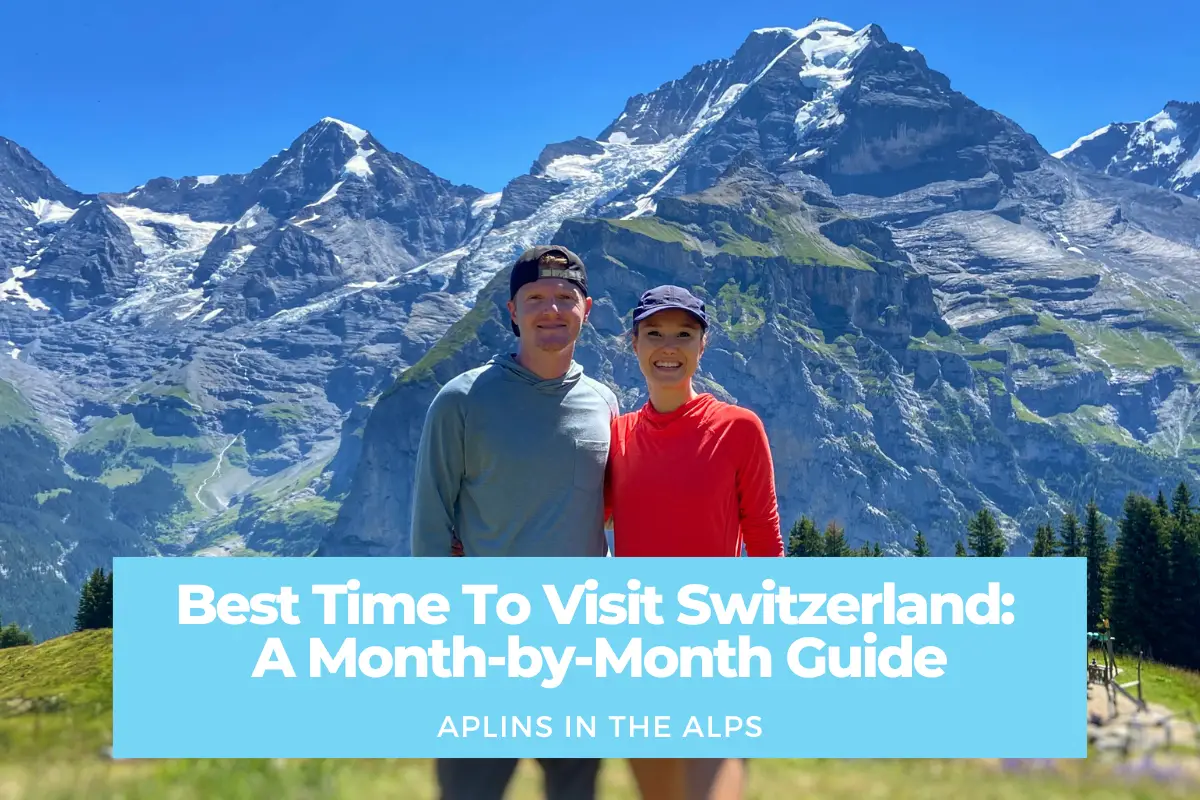
Keep on working, great job!